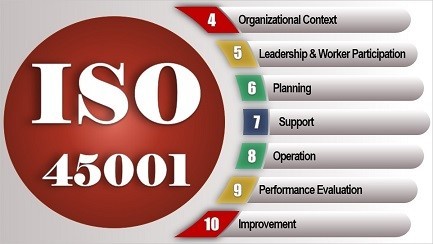
Why ISO 45001 is critical for workplace safety and health #ISO45001 #WorkplaceSafety #OccupationalHealth #ContinuousImprovement

Why ISO 45001 is critical for workplace safety and health #ISO45001 #WorkplaceSafety #OccupationalHealth #ContinuousImprovement
This article discusses the importance of implementing an occupational health and safety management system, as outlined by ISO 45001, to ensure workplace safety and health. It also highlights the benefits of continuous improvement in this area, emphasizing the importance of a proactive approach to safety management. By following the guidelines of this standard, organizations can reduce risks, comply with legal requirements, and enhance their reputation as a responsible and safety-conscious entity.
ISO 45001:2018, the international standard for Occupational Health and Safety Management Systems, provides a framework for organizations to improve the safety and health of their workers, reduce workplace risks, and create better, safer working conditions.
The standard was developed by the International Organization for Standardization (ISO) and was published in March 2018. It replaces the OHSAS 18001 standard and is designed to be compatible with other ISO management system standards such as ISO 9001 and ISO 14001.
The standard is intended for use by any organization, regardless of size or industry, and provides a systematic approach to managing occupational health and safety risks. It requires organizations to identify hazards, assess risks, and implement controls to eliminate or minimize those risks.
ISO 45001 emphasizes the importance of leadership and worker participation in the management of occupational health and safety. It requires organizations to establish a management system that promotes a proactive approach to safety and health, and encourages continuous improvement.
Some of the key requirements of ISO 45001 include:
Hazard identification and risk assessment: Organizations must identify all hazards associated with their operations and assess the risks associated with those hazards.
Legal compliance: Organizations must comply with all relevant occupational health and safety laws and regulations.
Objectives and targets: Organizations must establish measurable objectives and targets for improving occupational health and safety performance.
Resources and competence: Organizations must comply with all relevant occupational health and safety laws and regulations.
Objectives and targets: Organizations must establish measurable objectives and targets for improving occupational health and safety performance.
Resources and competence: Organizations must provide the resources necessary to implement and maintain their occupational health and safety management system and ensure that workers have the necessary skills and knowledge to perform their work safely.
Communication and consultation: Organizations must communicate their occupational health and safety policies and procedures to all workers and consult with workers on matters relating to their health and safety.
Emergency preparedness and response: Organizations must establish procedures for responding to emergencies and must periodically test those procedures.
Continuous improvement: Organizations must continually monitor and review their occupational health and safety management system and take corrective action as necessary.
By implementing an ISO 45001 compliant occupational health and safety management system, organizations can improve the safety and health of their workers, reduce workplace risks, and demonstrate their commitment to occupational health and safety to stakeholders.
ISO 45001 certification is not mandatory, but organizations that choose to become certified demonstrate to customers, suppliers, and other stakeholders that they have implemented an internationally recognized management system for occupational health and safety.
In summary, ISO 45001 provides a framework for organizations to manage occupational health and safety risks in a systematic, proactive manner. By implementing an ISO 45001 compliant occupational health and safety management system, organizations can improve the safety and health of their workers, reduce workplace risks, and demonstrate their commitment to occupational health and safety to stakeholders.